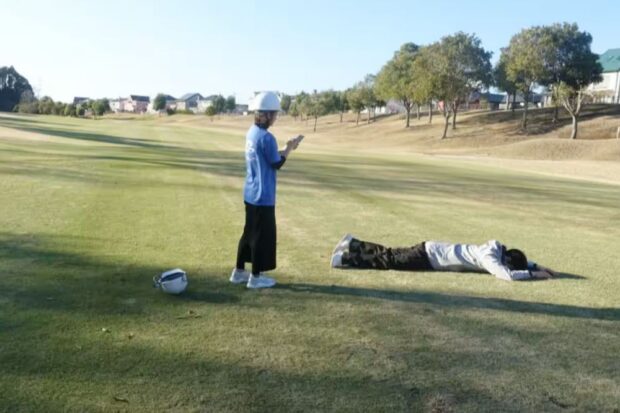Testing is underway in Japan to transport automated external defibrillators via drone at a golf course near here, hoping to quickly deliver assistance to golfers who suddenly fall ill.
Chiba University joined forces with Tokyo-based AirMobility, which develops flying cars, to conduct the trial in late March at the Kiminomori Golf Club in Chiba prefecture.
The test simulated a situation in which a golfer suffers a cardiac arrest while playing, and someone nearby calls for help.
First, the caller requests an AED using a smartphone app. Based on transmitted location data, the AirMobility-developed system then figures out the drone’s optimal course to the destination within seconds, avoiding houses, trees and other obstacles. A drone carrying an AED then automatically takes that route to the patient.
When the drone is flying, golf carts at the course emit warnings to notify other golfers about the aircraft. In the test, a drone flew to a destination roughly 400 meters away in about three and a half minutes.
AED transport trials using drones in Japan have typically involved manually operating the aircraft. At golf courses, it would be unrealistic to always have drone operators on call, and a person calling for help would be hard-pressed to describe precisely where the medical incident occurred. Automating the conveying of location and the flight itself is expected to make AED-transporting drones more likely to be commercialized.
Chiba prefecture, just east of Tokyo, is home to many golf courses because of its relatively flat geography. Many golfers are middle-aged or older, and deaths such as from heart attacks are not uncommon.
“Many requests for transporting patients by Doctor-Heli [air ambulance] come from golf courses,”
said Takaaki Nakada, head of emergency and critical care medicine at Chiba University Hospital.
Time is of the essence for cardiopulmonary resuscitation. But AEDs are kept in the clubhouse at many golf courses, so transporting them takes time. The survival rate is said to decline 10% or so for each minute that passes after the heart stops.
“The longer the transport distance, the more effective”
drone-based AED deliveries will be, an AirMobility official said.
Some issues need to be addressed before these drones can go mainstream. For example, the latest test had initially envisioned a flight of nearly 1 kilometer by passing over large trees. But the drone flew multiple practice runs, so its batteries ran out during the test itself.
“There were no technical problems, and we were able to confirm that the drone flew using our system at the golf course,” AirMobility President and CEO Hisashi Asai said. “We hope to commercialize this soon,” he said.
Plans call for deepening cooperation with medical institutions going forward, such as through joining hands with Chiba-based startup Smart119 so that an AED and ambulance can be requested at the same time.
“Golf courses are often used as evacuation sites in times of emergency,”
Asai said. He expressed a hope of broader future use of drones, such as for transporting medicine and relief supplies.
Top Photo: In this simulation, a person requests an AED using a smartphone app, at a golf course in Oamishirasato, Chiba prefecture – Rinano Katsu
Source: NIKKEI Asia


